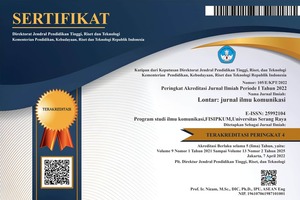Meaning of Thrifting in the #TukarBaju Campaign in the Zero Waste Indonesia Community
DOI:
https://doi.org/10.30656/lontar.v11i1.5626Kata Kunci:
Thrifting, Tukar Baju, Sustainable Fashion, Environmental CommunicationAbstrak
The phenomenon of thrifting or buying used clothes is becoming increasingly popular among young people and has attracted public attention because it is considered as one of the sustainable efforts by applying the principles of sustainable fashion.In interpreting this, the researcher then chose the Tukar Baju community as the object of research as well as a representation of environmental activists engaged in the realm of sustainable fashion. This research uses a qualitative method with an ethnographic type of research to see the meaning of thrifting from Tukar Baju activists and how the process of interaction and exchange of meaning between individuals can strengthen the meaning of thrifting as a form of sustainable fashion effort. Researchers found a pyramid concept of "Buyerarchy of need" in interpreting thrifting as a continuous effort and thrifting is at level 4 and which means thrifting is not the only one. So, to strive for sustainable fashion through thrifting, people need to be smart and not impulsive consumers.
Referensi
Buku
Andriva, A. W. (2020). Komunikasi Lingkungan Oleh Duta Lingkungan Dalam Melaksanakan Program Pelestarian Lingkungan “Sahabat Sungai Pekanbaru.â€. Jom FISIP, 7, 1-14.
Anshori, Dadang S. (2017). Etnografi Komunikasi Perspektif Bahasa. Depok: Rajawali Pers.
Cox, R. (2013). Environmental communication and the public sphere. Sage.
Creswell, J. W. (2016). Research Design: Pendekatan Metode Kualitatif, Kuantitatif, dan Campuran. Yogyakarta: Pustaka Pelajar.
Falkner, R. (Ed.). (2013). The handbook of global climate and environment policy. Oxford: Wiley-Blackwell.
Fletcher, K. (2013). Sustainable fashion and textiles: design journeys. Routledge.
Flor, A. G. (2018). Komunikasi Lingkungan: Penanganan Kasus-kasus Lingkungan Melalui Strategi Komunikasi. Prenada Media.
Haryono, Cosmas Gatot. (2020). Ragam Metode Penelitian Kualitatif Komunikasi. (n.p.): CV Jejak (Jejak Publisher).
Kamil, I. (2018). Peran Komunikasi Pemerintahan dalam Penanganan Lingkungan Kumuh. Mediator: Jurnal Komunikasi, 11(1), 129-139.
Rukin. (2019). Metodologi Penelitian Kualitatif. Sulawesi Selatan: Yayasan Ahmar Cendikia Indonesia.
Thompson, N. (2017). Textile Waste & The 3R's: Textile Waste Strategy Recommendations For The City Of Toronto.
West, R. L., Turner, L. H. (2009). Introducing communication theory: Analysis and application. New York, NY: McGraw-Hill.
Jurnal
Ahmadi, D. (2008). Interaksi Simbolik: Suatu Pengantar. Mediator: Jurnal Komunikasi, 9(2), 301-316.
Balqies, A. K. (2022). CAMPAIGN “THRIFTING†SEBAGAI SOLUSI LIMBAH FASHION. DEKAVE: Jurnal Desain Komunikasi Visual, 12(2).
Cuc, S., & Tripa, S. (2014). Fast fashion and second hand clothes between ecological concerns and global business. Annals of the University of Oradea Fascicle of textiles, leatherwork.
Dwivayani, K. D., & Boer, K. M. (2020). Gerakan Komunikasi Mitigasi Bencana dalam Upaya Meminimalkan Dampak Bencana pada Masyarakat Kota Samarinda. Jurnal Plakat (Pelayanan Kepada Masyarakat), 2(1), 1-7.
Gazzola, P., Pavione, E., Pezzetti, R., & Grechi, D. (2020). Trends in the fashion industry. The perception of sustainability and circular economy: A gender/generation quantitative approach. Sustainability, 12(7), 2809.
Ghilmansyah, R., Nursanti, S., & Utamidewi, W. (2022). Fenomena Thrifting sebagai Gaya Hidup Milenial Bogor. Jurnal Nomosleca, 8(1), 1-16.
Hayati, M., & Susilawati, N. (2021). Thrifting Sebagai Presentasi Diri Mahasiswa di Pasar Putih Bukittinggi. Jurnal Perspektif: Jurnal Kajian Sosiologi dan Pendidikan, 4(3).
Hibberd, M. (2018). Key challenges for the fashion industry in tackling climate change. Studies in Communication Sciences, 18(2), 383-397.
Khamis, S., Ang, L., Welling, R., 2016. Self-branding, ‘micro-celebrity’ and the rise of social media influencers. Celebrity Stud. Informa UK Ltd. 8 (2), 191e208.
Kurniawati, D. (2020). Komunikasi Mitigasi Bencana sebagai Kewaspadaan Masyarakat Menghadapi Bencana. JURNAL SIMBOLIKA: Research and Learning in Communication Study (E-Journal), 6(1), 51-58.
Maulida, N. R., Ni'mah, R. K., & Aini, R. N. (2019). Jualbeli Pakaian Preloved di Royal Plaza Surabaya Perspektif Kaidah Hukum Ekonomi Islam. El-Qist: Journal of Islamic Economics and Business (JIEB), 9(1), 46-57.
McNeill, L., & Moore, R. (2015). Sustainable fashion consumption and the fast fashion conundrum: fashionable consumers and attitudes to sustainability in clothing choice. International Journal of Consumer Studies, 39(3), 212-222.
Nurdin, M. (2021). Pengaruh Strategi Pemasaran Islami Terhadap Keputusan Pembelian Thrifting di Instagram pada Masyarakat Surabaya. Nomicpedia: Journal of Economics and Business Innovation, 1(2), 89-101.
Pane, D. M., Punia, I., & Nugroho, W. (2018). Fashion Sebagai Penciptaan Identitas Diri Remaja Di Kota Denpasar. Jurnal Ilmiah Sosiologi (OJS), 1(2), 1-8.
Setyaningsih, A., Bahari, N., & Ardiyanto, D. T. (2018). Kuasa Baju Bekas: Kode Kultural Fesyen Baju Bekas Dalam Ranah Industri Kreatif. Jurnal Industri Kreatif dan Kewirausahaan, 1(1).
Stringer, T., Mortimer, G., & Payne, A. R. (2020). Do ethical concerns and personal values influence the purchase intention of fast-fashion clothing?. Journal of Fashion Marketing and Management: An International Journal.
Susanti, S., & Rachmawati, T. S. (2018). Menumbuhkan Kesadaran Hidup Ekologis melalui Komunikasi Lingkungan di Eco Learning Cam. Mediator: Jurnal Komunikasi, 11(2), 188-202.
Syafrizal, S., & Karimah, N. U. (2014). Motivasi Masyarakat Membeli Pakaian Bekas di Pasar Senapelan Pekanbaru (Doctoral dissertation, Riau University.
Tan, A. M., Sarmiati, S., & Elfitra, E. (2019). Komunikasi Lingkungan Sebagai Upaya Pencegahan Kerusakan Lingkungan Kawasan Wisata (Studi Deskriptif Pada Pemerintah Kabupaten Pesisir Selatan Di Kawasan Wisata Mandeh). Jurnal Komunikasi, 13(2), 97-108.
Wisnuwardhani, L. (2015). Upaya Peningkatan Penjualan Baju Bekas Melalui Media Facebook (Studi Pada Viee Second Kalla). Jurnal Administrasi Bisnis, 18(1).
Andriva, A. W. (2020). Komunikasi Lingkungan Oleh Duta Lingkungan Dalam Melaksanakan Program Pelestarian Lingkungan “Sahabat Sungai Pekanbaru.â€. Jom FISIP, 7, 1-14.
Artikel di Internet
Gafara, Ghesa. (2019). A Brief History of Thrifting
https://www.ussfeed.com/a-brief-history-of-thrifting/, diakses 1 April 2021.
Putri, Ann. (2021). Bagaimana Internet Mengubah “Thrift Shoppingâ€
http://remotivi.or.id/mediapedia/659/bagaimana-internet-mengubah-thrift-shopping, diakses 1 April 2021.
Thamrin, Mahandis Yoananta. (2019). Demi Kelestarian Bumi, Ayo Bertukar Baju!
https://nationalgeographic.grid.id/read/131717564/demi-kelestarian-bumi-ayo-bertukar-baju?page=all, diakses 1 April 2021
Unduhan
Diterbitkan
Terbitan
Bagian
Lisensi
By submitting an article to the journal, the author(s) agree to transfer the published article's copyright to the journal, which will act as the publisher. This means the journal will have the right to publish the article in various forms, including reprints. The journal will maintain the publishing rights to the published articles.
In line with the license, authors and third parties (readers, researchers, and others) are allowed to share and adapt the material. In addition, the material must be given appropriate credit, provided with a link to the license, and indicated if changes were made. If authors remix, transform, or build upon the material, authors must distribute their contributions under the same license as the original.





